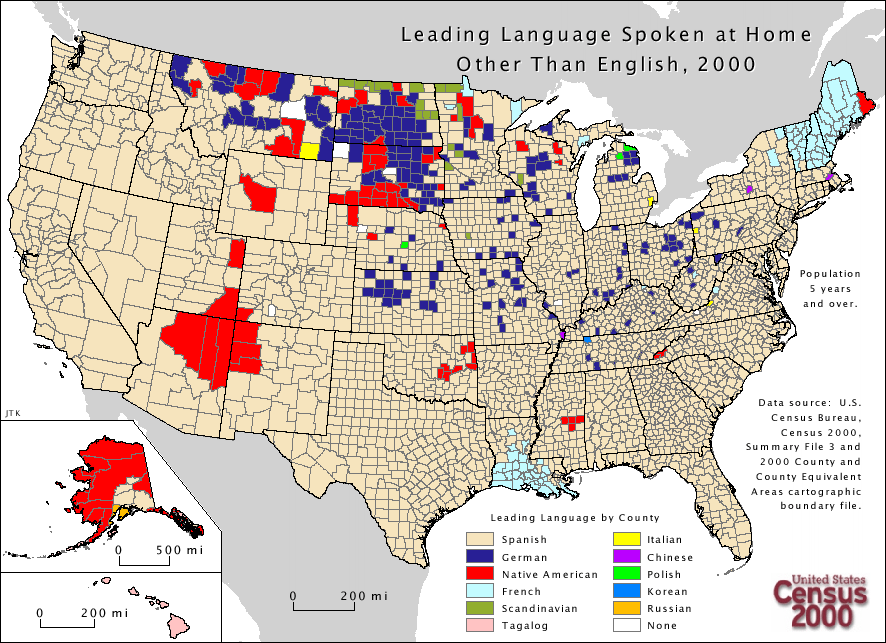And the verdict for much of the country is…unsurprising! Take a closer look to see pockets of German, French, and Scandinavian speakers up north as well as Native American speakers in the southwest.

What have we here? Map by U.S. Census Bureau
And the verdict for much of the country is…unsurprising! Take a closer look to see pockets of German, French, and Scandinavian speakers up north as well as Native American speakers in the southwest.

What have we here? Map by U.S. Census Bureau
 Photo Courtesy: Yale Press[/caption]
In this article by Yale University Press, former MacArthur Fellow Peter Cole reads two poems from his volume of Kabbalah translations, The Poetry of Kabbalah: Mystical...
Photo Courtesy: Yale Press[/caption]
In this article by Yale University Press, former MacArthur Fellow Peter Cole reads two poems from his volume of Kabbalah translations, The Poetry of Kabbalah: Mystical...
Ever thought of taking a Chinese language class? Often regarded as one of the world’s most difficult languages, Haike Bruneel of the Hutong School elaborates on five reasons why she believes that the language does not live up to its challenging reputation:
1. Characters can be written phonetically
2. Tones can be challenging, but their use is often understandable through context and the grammatical position of the word within the sentence
3. Grammar is very simplified
4. Vocabulary features combinations that often make sense
5. Most characters are phonetic, making it easier to read once the phonetics are understood
As an example, Bruneel writes with respect to tones:
“Because the Chinese language has so few different syllables, tones are being used. In Mandarin, the official standard language, there are 4 different tones, as well as a neutral tone, which is however only used very rarely. The 4 tones allow pronouncing the syllables in different ways, so that different meanings can be conveyed.
Learning to hear and pronounce these tones correctly is a challenge for anybody who’s never learned a tonal language before. Yet, its importance should not be overstated either. Usually, up to an intermediate level, it will be perfectly clear which meaning is intended, even if you pronounce or hear a tone incorrectly.”
In addition to determining the context and grammatical position of each word, she mentions the disyllabic nature of most Chinese words as another key factor in distinguishing between varying tones. This reduces the chances that words with the same spelling will be confused with one another.
If you are currently studying or teaching Chinese with GLN, do you agree with the Bruneel’s reasons? Do you have any tips that might make the language easier for others to learn?
Quartz has a great story about the Indian mobile market, the second biggest market after China. What’s keeping it from blowing up?
There are officially 21 recognized languages in India, each with its own script. And while India is known as an Anglophone nation, speaking English is largely the domain of middle or upper-class educated urban folk. A lot of them communicate phonetically using the English alphabet, but that doesn’t work for the rest.
The majority of Indians (70%) live in rural areas and can’t functionally use their English phones.
It’s interesting to see how Abhijit Bhattacharjee has approached this design problem:
Bhattacharjee’s solution is ingenious. Panini Keypad, named for a Sanskrit linguist, turns the screen into a virtual keypad corresponding to the 12 buttons on older phones. After a user types in the first character of a word, the phone displays a set of letters in a 3×4 grid corresponding to the keypad. An algorithm picks the characters it thinks will most likely come next, based on a corpus of literature from that language. Instead of clicking repeatedly until the right character is displayed, the user can pick one from that set or go on to the next screen.
The above image shows what the (now dead) Sanskrit language- the parent of many of today’s Indian languages. Each letter undergoes a variation when you go from “ka” to “kee” or “kay,” which works out so intuitively with pen and a paper. To reduce that into a 12-button phone is a phenomenal task that will empower rural peoples with an important communication tool that they’ve effectively been sidelined from using.
The Lingua File profiles the Urdu language in this post from last month. Spoken by more than 60.6 millions speakers, Urdu is the official language of Pakistan. It is often spoken along with English and a local indigenous language.
A notable topic discussed in this profile is the preferences in word choice in Hindi and Urdu when the languages are used in formal and informal contexts. In most cases, the origin of the word determines the social context in which it is used:
“Etymology of words is used to help decide how polite someone’s speech is. It’s like how in English, words of French origin are often considered to be more formal than those from Old English. You’d never say ‘let’s commence eating’ in an informal situation. You’d use the word start instead, unless you were just being silly. The same goes for Urdu. For example, there are two words meaning ‘water,’ پانی pānī and آب āb. Words of older Hindustani or Sanskrit origin such as pānī are used coloquially, whereas words of Persian or Arabic origin such as āb are used in formal situations.”
If you are a taking a GLN course, can you think of any examples of words from your class that are best used in formal situations? What words would you use for informal situations?